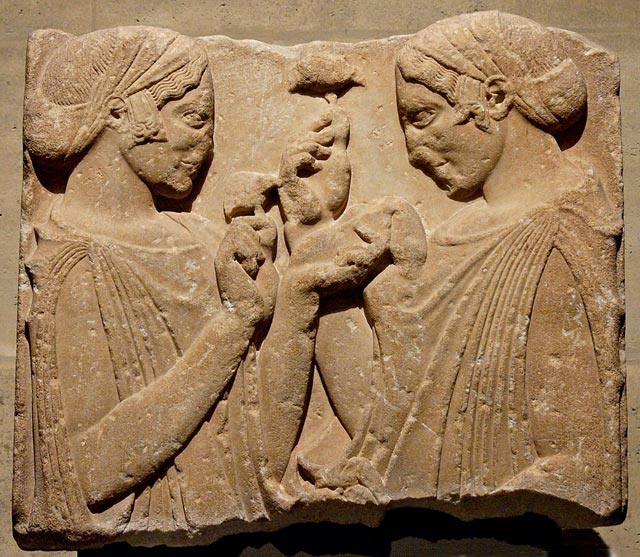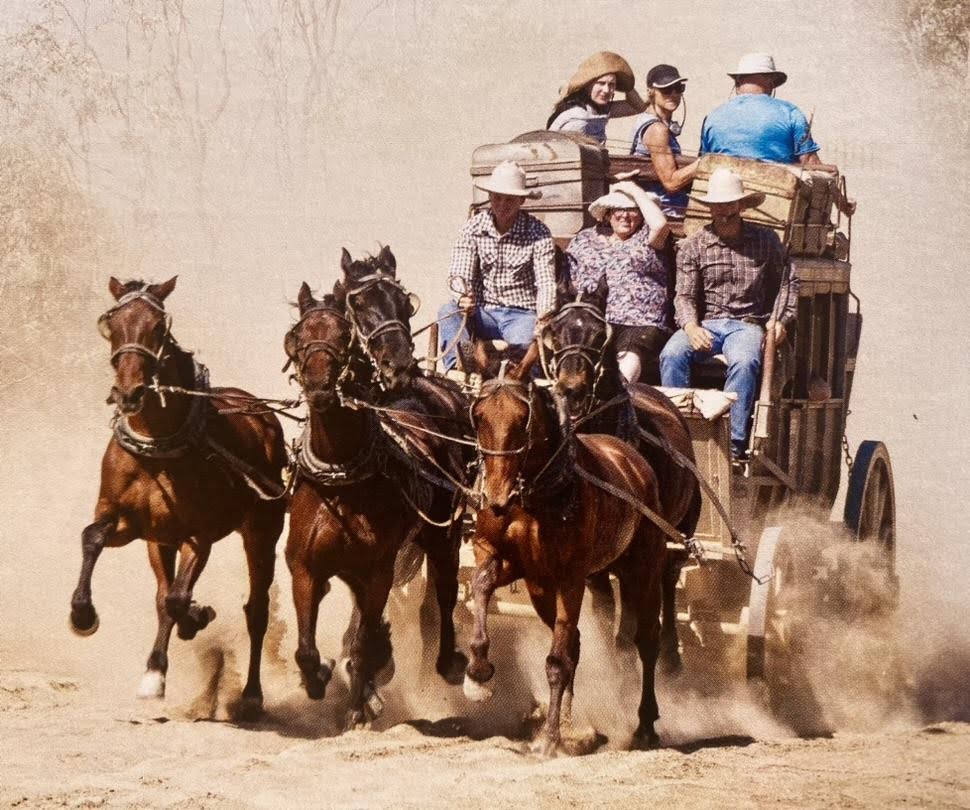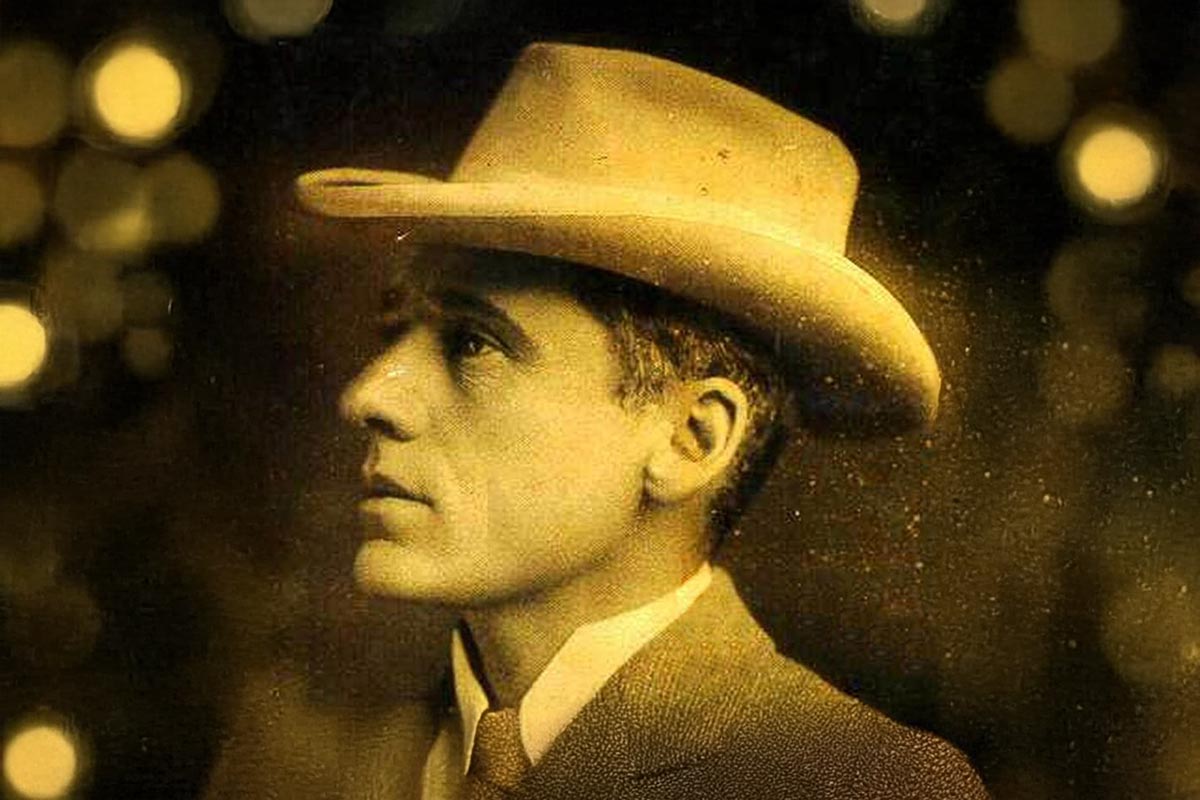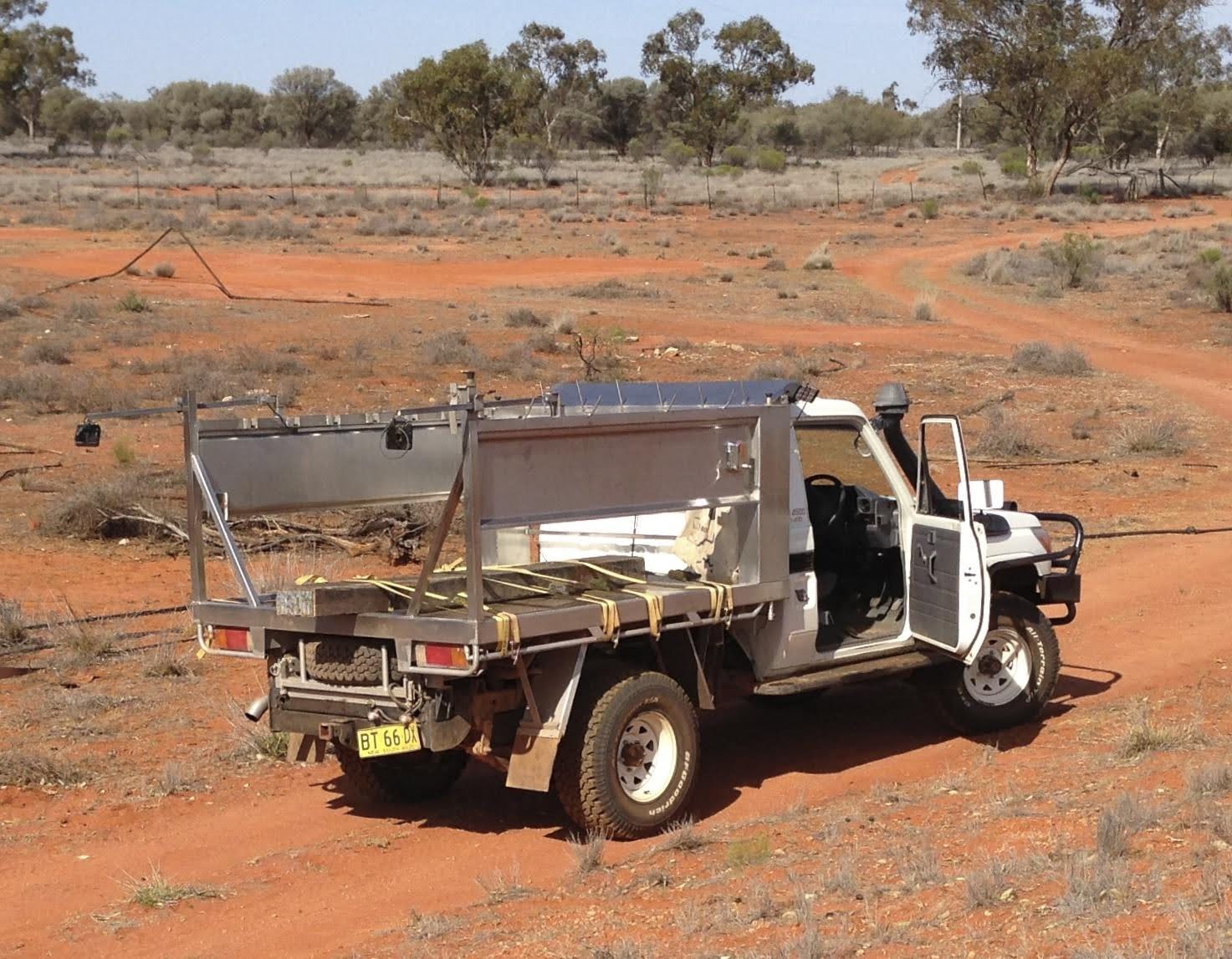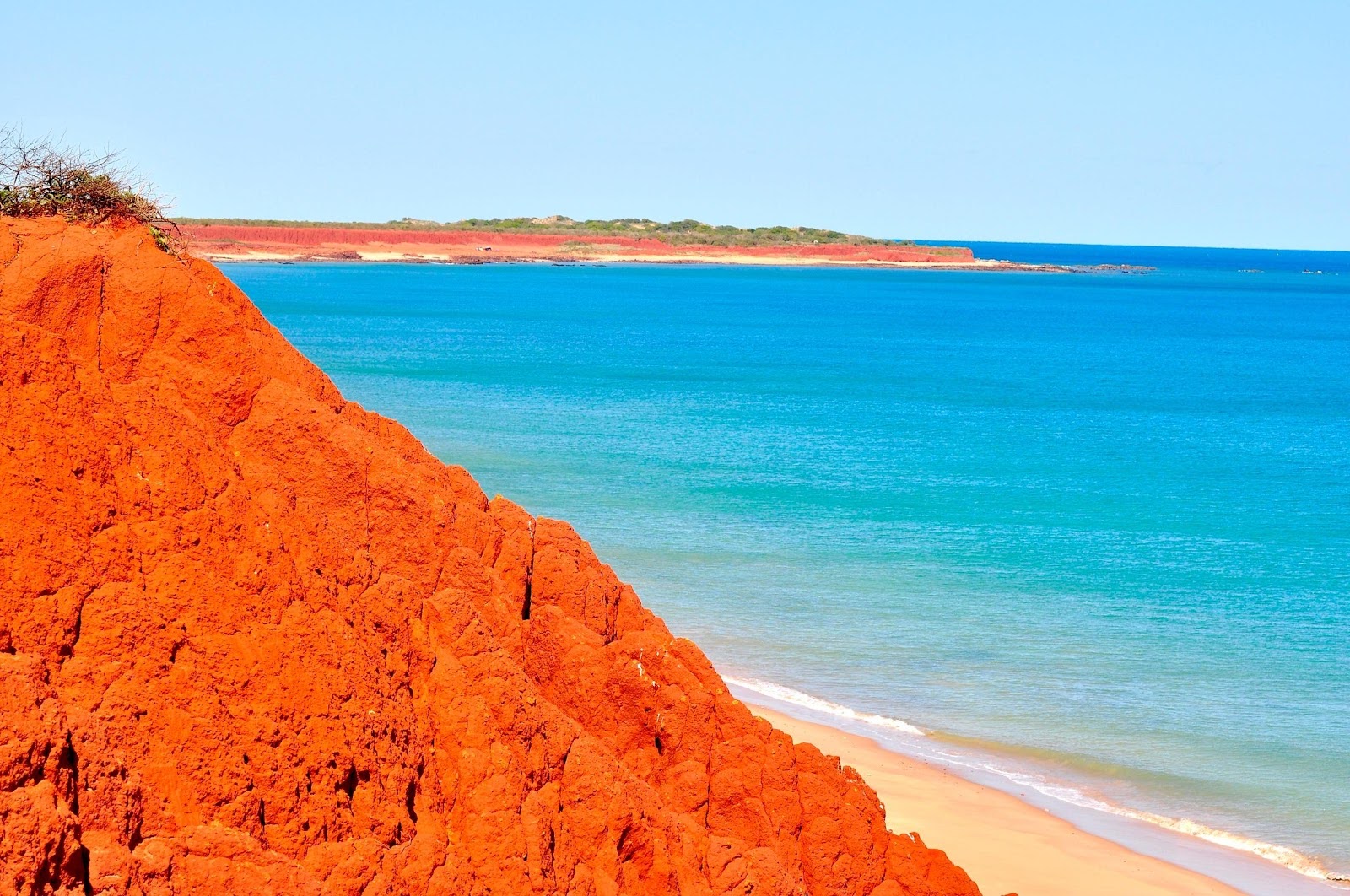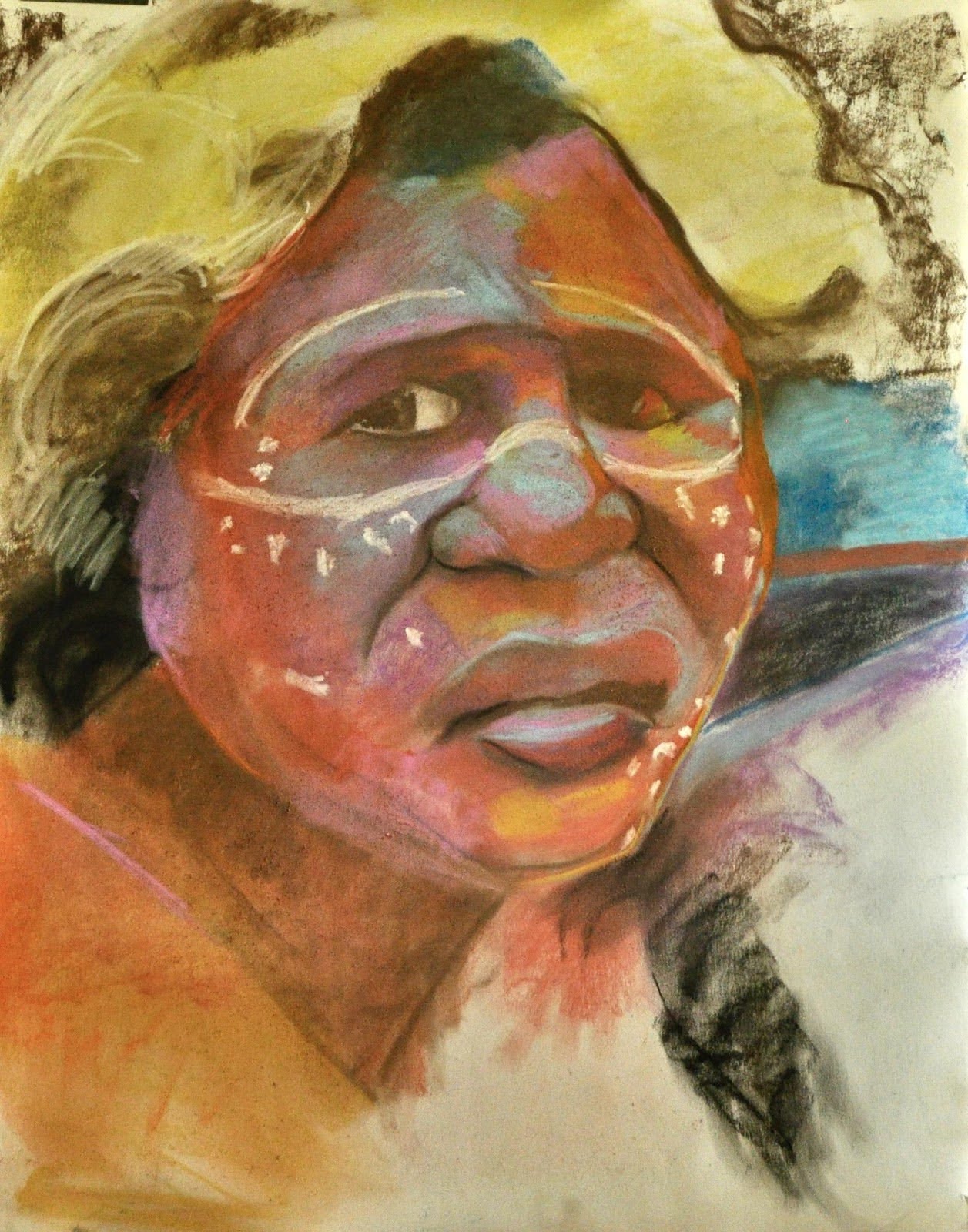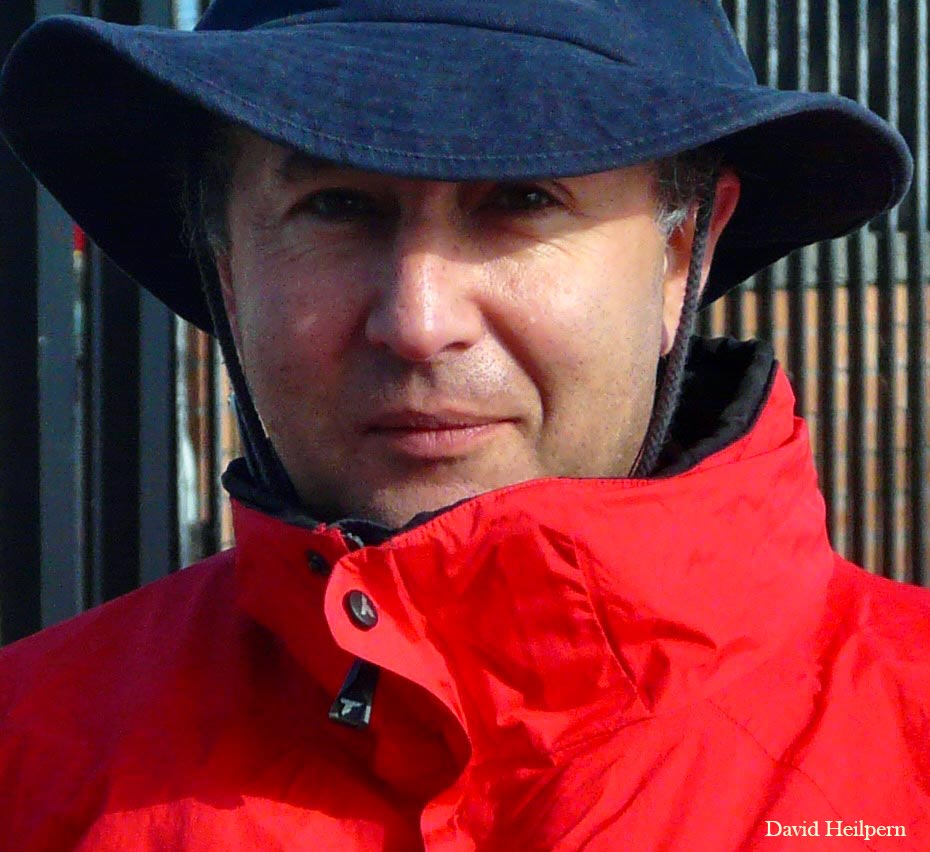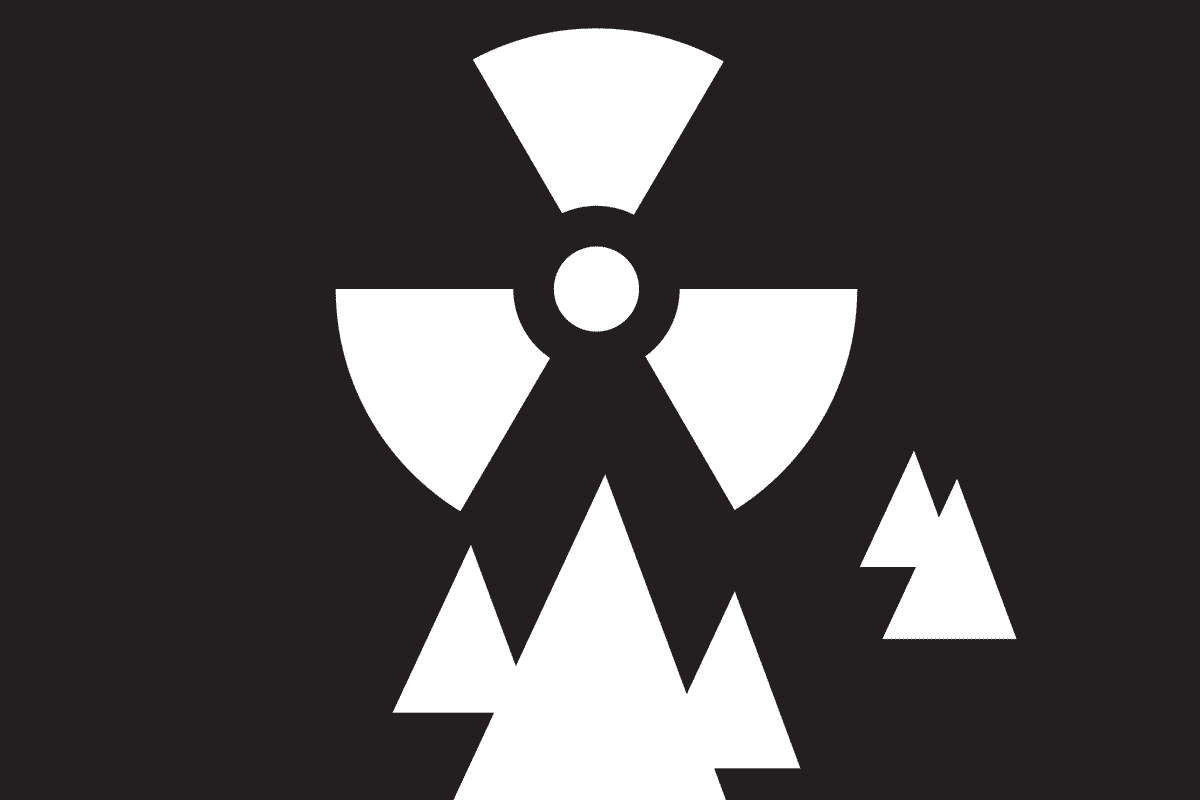Already past the point of no return on another adventure, I woke alert at 2:00 am, wondering under the stars what better preparations I might have made for six hundred kilometres along beaches and cliff tops of The Great Australian Bight, following the old telegraph line northeast from Esperance, the name of d’Entrecasteaux’s ship anchoring there in 1792, still whispering its sibilant message to country whose spirit I would breathe all the way to Eucla, via the Eyre Bird Observatory.
Over decades I’d heard of this trip, and crossing the treeless Nullabor Plain had previously seen the magnificence of The Bight: Its limestone escarpment, rising a hundred meters from The Great Southern Ocean and 1,100 km in length, boasts the longest unbroken line of cliffs on earth, but I had no idea of the significance of the 1,200 km Inter-Colonial Telegraph Line.

It was built by a Scottish swindler, James Fleming, who after serving his convict term was granted a Ticket of Leave, became a newspaper reporter, headmaster of a boys’ school, then took charge of constructing the telegraph line, completed in two years.
From 1877, this single strand of wire brought Western Australia into direct telegraphic communication with the other Australian colonies and, via Darwin and submarine cables, with Asia and Europe. Previously mail took six months from London and three weeks from the eastern colonies. Inspiring a sense of nationhood for quarter of a century before federation in 1901, the old telegraph was replaced in 1927 after fifty years by another line along the new Trans Australian Railway, 200 km to the north.
Passing through Esperance, I found the Shire Offices, Tourist Information and Department of Conservation and Land Management all disconcertingly vague about my proposed route, so I checked the tides and made a final visit to a local surveyor and amateur fisherman, saying,
I’ll be driving up the beaches to Eyre.
Breathing in, raising eyebrows and looking into the distance he asked,
Do you have an EPIRB? (Emergency Position-Indicating Radio Beacon)
No.
Do you have a sat-phone?
No.
You’ll get your vehicle scratched.
I shrugged.
It is do-able, he said. I can set you up with the maps… six sheets.
How much?
$15 each.Thanks, but I have a GPS. (Global Positioning System)
Do you have a good pump?
Yes, two.
You’ll need to let your tyres down to climb Wylie’s scarp, then re-inflate for the rocky road on top. … At Twilight Cove, you’ll have to get through extensive dunes to reach the beach and then drive north on hard sand exposed at low tide. … Don’t drive into seaweed on the beach. You’ll never get out. … I’ve been up there several times for rescue. … Down this end you might see two or three other vehicles a day, but up the other end, maybe one in three weeks.
Leaving town, Fisheries Road ran due east becoming gravel then sand requiring four wheel drive to reach Israelite Bay, quaintly so named when settlers noticed indigenous men were circumcised, while they in return joked that such a silly fence with only one wire so high above the ground would never stop a kangaroo, but the importance of the line in its time is clear from the substantial limestone ruins there today of a telegraph repeater station.
Waiting for low tide, but missing the track through thick scrub to the beach, I followed an inland route along the telegraph line. A few Jarrah posts still stood; 4”x4” timbers shipped from their forests, to be floated inshore, then winched up sea cliffs by teams of horses and hauled to site.
Once taught in the air, pulsing with dots and dashes of encoded messages, pregnant with affairs of trade, of state and doubtless of the heart; once a vital link in consciousness attended continuously by linesmen on horseback, the old wire now lay rusting, serpentine along the track, wriggling in death throes under my tyres.
Climbing the scarp was easy on wide rubber conveyor belting discarded by a mining company and donated to local fishermen, who pegged it in two parallel black lines up the steep white sand. While I ate lunch at Point Culver, which in 1801 had reminded Matthew Flinders of the Isle of Wight, my trusty mount, Ganesha, Indian elephant god of wisdom, of breaking through barriers, of prosperity and of having a good time, rested but two meters from the edge of cliffs plunging vertically to the ocean, where colliding swells undercut their base and rebounding against themselves discharged in flurries of white, falling back onto jade battlefields, like cavalry repulsed in a lather of slaughter.
All afternoon, I walked this ancient battlefront, wildflowers at my feet, swallows wheeling and fluttering above those rose and creamy ramparts. Charged with their grandeur, with the forces contending there, with salt air, polar influences and uplifting solitude, I felt restored; forgiving the arduous track, whose austerities after all, meant I had to myself this wild place on some of Australia’s most remote coast.
From cliff top height, looking both ways along the Bight, I counted a dozen abrupt headlands till their bold outlines faded into sea mist well short of the horizon, over which in both directions the edge of the continent still visibly curved, indicating the wayward path by which I had come and by which I would continue after sheltering in a hollow from a cool southerly overnight.
Another half-day’s journey and I walked equally delighted along the Baxter Cliffs, perching at night like a bird behind a clump of bushes; next morning finding the memorial to Baxter, murdered in 1841, “at the dead hour of night … ”, by natives who absconded with provisions and firearms, leaving the explorer Eyre, as he wrote,
… in the wildest and most inhospitable wastes of Australia.”
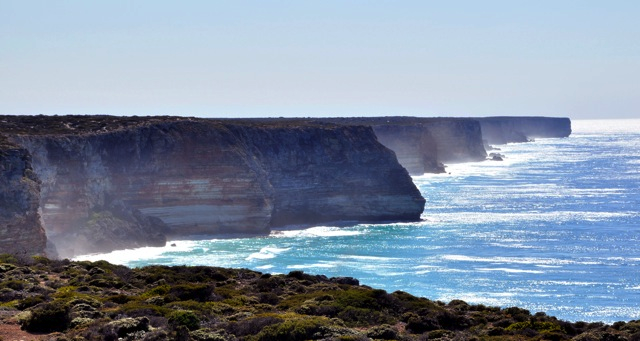
The track on was hard to find. Casting about, at last I spied a faint impression on the ground, which continued faint, unlike scratches along my vehicle, but reassuringly, there, lying on the ground, was the old telegraph wire, leading forward into daunting wilderness, where misfortune or error might warrant a sat-phone, or EPIRB. Some exaggerate difficulties and dangers of terrain, while others prefer understatement, but was a mate having a joke on me, recommending this route, the best part, he said, of his big lap around the country?
The way was cruel. Rocks and sharp stones alternated with deep soft sand and with sand and rocks mixed together. How did these dunes get so full of stones, I wondered as I built muscle swinging the wheel this way then suddenly that around bushes and tyre-slashing hazards on our tortuous way; ever winding sharply through prickly scrub, over stony ridges and under low branches which tore the roof rack tarp; but the roughest roads lead to the nicest places.
Hissing out their rubbery breath, tyres let down to 25 psi looked fat and flabby, as I was before leaving town twenty years ago. Poor things, thought I, regarding the weakest link in this adventure; so vulnerable, but no sense re-inflating for harder ground so frequently alternating with sand, though their sidewalls did bulge ominously. At a gentle walking pace however, there was nothing to stop us. Precautionary slowness to avoid damage would be better than an EPIRB, or any techno-fix after a crisis. Festina lente! If only the globalised frenzy, which Beethoven announced with his portentous Da Da Da Daaa! – Da Da Da Daaa!, could moderate to the calmer moods of some of his later movements! Slow is beautiful. Wisdom itself is slow.
Even at walking pace, I often braked hard for fat tailed lizards sunning in pairs on the track; thrusting out their purple tongues when tickled with a twig. All bluff, they have no other defence. With a taste for lizard, one could live well in this country, but fish are 100 metres down cliffs and are few in number in their marine desert, ill nourished by any runoff from arid infertile land; albeit high in diversity of species, as occurs paradoxically in lean ecosystems.
Taking wrong turns, getting lost and dreading spikes through bulging sidewalls, I had to retrace breadcrumb trails on the GPS, back to the rusty old wire threading the scrub, so I liked the electronic gadget, although the first precaution with a GPS is to take two, enough spare batteries and a paper map also. Sure, I could walk out of here, but my surest guide would be that old line, discarded but still trusty after 130 years; reliable even now dead on the ground.
It became to me the skein of red fleece, which in Greek myth Ariadne spun and falling instantly in love gave Theseus. Attaching one end of Ariadne’s thread to the entrance of his labyrinth, Theseus unwound it loop by loop as he trod ever deeper into danger, so that having volunteered and slain his monster, the hideous Minotaur to which he and his party would be sacrificed, Theseus could then retrace his steps along the string. Sailing home to become the founding king of Athens, our hero abandoned his importunate lady, asleep on the island of Naxos, where her husband Dionysus reclaimed her.
At Twilight Cove the escarpment veers inland. There, under the eye of a patrolling eagle riding the updraft, I forsook Ariadne’s stratagem. Leaving the wire behind I turned seaward, down the wall to enter a great bay of sand as fine as icing sugar, blinding, white as snow, and driven into great waves romping out to meet Southern Ocean breakers rolling in.
Waiting for low tide I lunched at water’s edge, then tapped out sentences through laptop keys and tended my good elephant’s wing mirrors and tyre pressures, before heading northeast along hard sand below high water mark; but this beach was not like the grand open beaches of Fraser Island. It was narrow and complex with ridges, washouts and potholes.
Even at low water, banks of seaweed up to my waist ran out into the surf; thrown up from the wilderness of the deep by the last southerly gale and dumped there with Antarctic authority. Leaving Ganesh I walked between piles of kelp, richly coloured like old tapestries, strewn thickly on the sand, camouflaging resting shorebirds.
Reluctant to disturb them, I returned to Ganesha and retraced the track to camp in shelter behind the dunes, relishing veggie curry and good sleep before going back next morning to watch the tide like a surfie. Welcome swallows swooping through my van, stalled in mid air, fluttering, looking for a corner in which to nest, as if I were not there. Their disregard felt to me ironically like a welcome. It seemed I had already joined their natural world and might add to their wellbeing, if only a little shelter, or a few strands of beard for their nest.
Then followed four perfect days, crossing white dunes to breakfast in sunshine by the water amid hummocks of weed, brown, black, amber, green and pink, the ocean murmuring at my office door; fingers on keyboard till lunch; then all afternoon with binoculars, camera and notebook, walking the beach finding young shearwaters, one dead, probably from hunger and another on its back in the water, helpless till rescued, but sadly I had no sardines to offer.
Identifying Silver gulls, Kelp gulls, Pacific gulls, Pied cormorants, Sooty oystercatchers and Sharp-tailed sandpipers, I was less confident about Red-necked stints, or Sanderlings and saw neither penguins, sea lions, nor migrating whales at this season, but felt fortunate, elated near roosts populated with brave adventurers guided by some inner thread to rest like me amongst the tangled weed. Returning to Ganesha we clambered back through swerving dunes into shelter; sorting photos till dinner.
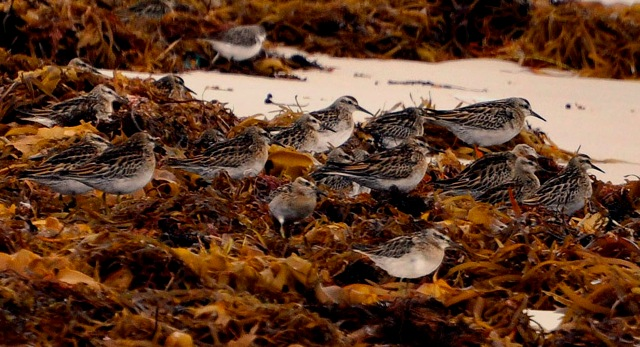
Once bogged in sloppy sand, surf swirling between Ganesha’s wheels, a rising tide and darkness falling, I was more prudent this time, assessing the beach and weather, waiting to negotiate these tricky sands with the tide ebbing early in the morning. Finally, down to my last tomato and crust of stale bread, I bypassed the roost, driving behind the dunes before rejoining the beach to run below high water mark, pausing between wave sets to skirt obstructions, but after ten clicks low cliffs jutting out into the sea turned us back. An awful track climbed steeply above the rock face, heading inland, back towards the telegraph line.
Passing ruins of a tin shack, once some hermit’s hideaway, I smiled recalling such an earthy humpy in dunes, away with the birds – away from urban madness, was once my own dream too. How better to know oneself – than by oneself, enjoying the best of company, undiluted, not distracted, alone with the beloved? Forsaking attachment to place objects and people also, nomadic mobility assists withdrawal, particularly now that even remote country is developed and ever more controlled under a second wave of invasion by the ubiquitous four-wheel drive.
And what a remarkable carriage to contentment my elephant is! On any bush track, a Toyota would have made it, so a Land Cruiser is the best chance of getting through. Oh what a feeling tip toeing, putter putter, in this nigh impenetrable terrain! Oh what a feeling it will be back on the blacktop doing the ton with the rest! Never a rattle, nor a squeak; just that rubbery Toyota reliability, the resilient suspension transmitting into my bones the texture of the land, gladly incorporated along this whitefella’s songline, and absorbing the Aboriginal Toyota Dreaming.
My word, you’ve looked after this one, exclaimed a mechanic in Karratha replacing the second timing belt at 300,000 km. It really shows!
My life and survival depend on it.
Jeez mate, you’ve got a good setup there, is the almost invariable greeting of many a stranger, to which in Ozi laconic I’ve learnt to answer dryly, Does the job.
Many along the way ask, How’s ya Toyota goin’?
Fine, I reply. They go well if you spend money on ‘em … Decay is inherent in all compound things. … All mechanisms need proper maintenance … our bodies included. … Toyotas’ amazing capabilities call for running costs in proportion to how and where you drive them.
But, by what narcissistic sense of entitlement do I allow myself to muster all these materials to my microcosm, all this energy? It all comes from the Earth! With what grandiosity do I harness her resources for my adventure, comfort and pleasure, riding a white elephant like a maharaja through the desert? Driven by global culture, serviced by huge industries, funded by surplus value plundered then sequestered from the earth, what prodigal spending of Gaia’s substance!
Never otherwise, but seeing any step out of dominant culture had to be in the right direction, I left house, home, professional practice and urban values for personal downsizing and voluntary simplicity long before those terms were current. Integrity meant walking the talk, as all will do in limiting days. We thought we could bring change, but though it now seems too late to help, at least I’ve had a life. In the bush it all becomes more clear and having done it both ways thoroughly, the former was as sickening to me and to most others, as I find the latter healing.
Spare, vegetarian by preference, driving little further than an average commuter, my nomadic life taxes the earth less than house dwellers, though that’s not saying much in Australia. Admittedly, many have several houses and several cars. Even so, on the road for decades, I am deeply compromised. I claim no higher moral ground. All are complicit. My feral way of life is still an undue burden on a finite planet. And what if all were to share my privilege? Dissenting from dominant culture for love of the earth, I am no less, loving her to death. There is no hiding. How far out must one go before sitting with as little impact as indigenous people before us, or a hermit in a humpy now?
In the macrocosm, growth economics is already past the point of no return and has such momentum that its voracious appetite, like Theseus’ devouring monster’s, can end only by its ruin, as its greatest critic foretold; especially when that momentum is multiplied by the mass times velocity of cascading other factors such as runaway population, surging per capita consumption, soaring health and military budgets, mounting economic and financial instability with executive pay rewarding undue risks; factors like peak oil, water and food, global warming, climate change, degraded land, air and water; habitat loss, mass extinction of species, increasing alienation and religious fundamentalism East and West. Witness the failure of Hansen, Lovelock, Suzuki, Kyoto, Copenhagen and Obama. Only one in five is capable of voluntary change anyway, and of that fifth how many trim behaviour for the future of their children, who live more recklessly, squandering Earth’s substance even more extravagantly. Why such a meditation, however, in the bush, other than going headfirst along an ever-narrowing track?
Three and a half tons sliding sideways down loose gravel into steepening washouts with no option but to continue, the truck leaning ever more precariously, I wondered again and again that it hadn’t already rolled onto its side into a gully with a grating crunch against the lower bank; not Titanic; not life threatening in itself and all good practice for the final descent, which will come, hopefully for me while still venturing, into the interior at least; but feeling a bit way out now, I was asking again whether I should have come this way.
If my vehicle did roll, then where would I be? I’d have to climb out the back, or through the passenger door and walk three or four days along the coast. My big rucksack was a lifeboat for such an emergency, but with only a daypack now, how would I manage, in particular for water, Eyre’s besetting difficulty in this
“bleak, harsh, unyielding terrain, as he wrote. … No rivers or streams irrigate this dry, dusty land.”
These, however, were only dreams. I was doing fine, both on the ground and within; not least because, more vital than conveyance food or even water, the breath, for decades in disciplined awareness, ran freely between the thumb and forefinger of consciousness, like Ariadne’s skein falling loop by loop from Theseus’ hand. Likewise, the invisible strand of respiration, when carefully attended like the telegraph line, ensures best passage wherever.
Moreover, I’d left the telegraph line behind, and having turned my back on the metaphor was thus brought home to the breath itself, the last of our addictions. By extension, when that thread also is let go, as I had abandoned the wire, what might the inner terrain be like? Surely no pricklier than this! Three minutes on beyond life’s horizon, with the senses fading into mist, the way could be no rougher – nor more joyful than life on the road and in the bush.
Meanwhile, what better reference, what better constant presence against which to plot the wandering mind, than the breathing – rhythmic, sensuous, seductive, autogenous and autonomous? Each exhalation, the final common pathway of metabolism, a warm exhaust charged with spent fire, high in carbon dioxide which it ventilates, heavy with thought and work which it lets go; turbulent with valid emotion which it discharges. Cleansing body and mind, it also brings both together into harmony and into peace. Orienting perception like a compass needle, ever pointing towards our fate, it leaves the wits inspired, the body reconciled, resigned and ready to be filled again with oxygen, indispensible so far.
Every inspiration, refreshing as Sothern Ocean air; each expiration setting the heart free, like a telegraph pole falling, dropping its burden, yielding to decay, rotting beside the wire. How better to find peace in the heart, peace of mind, peace with oneself, if not with the frantic world, than by owning and letting go the sum of bodily processes manifest in breath release; allowing air and flesh to find their true relationship, unconstrained by culture, in equilibrium with the environment, unorthodox, unique, quintessentially weird and profoundly biological?
Communicating directly with every cell, the breath is like the online Web. From sub-cellular, even from sub-molecular depths of inner space, it signals continually, but still like Morse pulsing to and fro along that telegraph wire, the cadence of the breathing coursing up and down its airway signals all states of mind and body from first to last, throughout life’s journey, from birth to death, in rough and smooth, thick and thin, quavering accurately to every nuance of the great adventure, the wondrous escapade of life.
If The Bight is the longest continuous cliff line, the hard bitten rind of a sizeable chunk of the globe, it must be a significant feature, visible from outer space; albeit in Ozi fashion, worn down, low profile, understated like the humble continuum of breathing, coextensive with life’s span, a salient feature decipherable by others from afar, as birds to keen observers are. Locating exact position in the inner landscape it also leads us on: Just follow the lifelong succession of breaths, looping like that old wire between its poles and it will guide us reliably, inevitably home to life’s last landmark. I have no better datum for my path.
Climbing six kilometres, back up the escarpment, the track was free of wheel marks and so overgrown with low branches that I had to use the axe, or barge our way around obstructions. There’d been no vehicle here for three weeks, let alone three years. Broken twigs and sticks were piled half way up the windscreen. Slapping through the driver’s window, springy branches smacked my face and left it stinging, but happily, no punctured tyre! Not yet.
Not desperate like one who gasps for air, but more like awareness returning to the breath in one whose attention wavered, I slowly made my way back to the telegraph line. What a sigh of relief will follow when a clearer passage opens! As those who sleep so deep they cease to breath, till waking startled with a jolt, suddenly I found the wire again; there at right angles across my course, heading unerringly, straight as a die to Eyre, but no longer lying on the ground between fallen posts, it was now suspended on tapered iron pillars, elegantly cast in London. Looping low enough however, the wire dragging on Ganesha’s roof, wriggled in the air above with new life, re-inspired. That early start on a falling tide had got us with daylight to spare, not only along the risky beach, but through this dense scrub also. Would a real bushman do much better, except by staying away?
Strategically located for ornithology, The Eyre Bird Observatory occupies a wintering place for gannets, petrels and albatross, up from Antarctica. It is also in a summer feeding ground for honeyeaters down from northern deserts and it’s on a migratory path along the coast. All three overlap resident coastal populations. It boasts 240 species, including the rare Major Mitchell Cockatoo, the Buff-breasted Sandpiper and the Mallee fowl, which incubates its eggs, maintaining their temperature uniquely on heaps of composting leaf litter.
In 1977 the Observatory claimed and restored the former Telegraph Station, abandoned fifty years before and built fifty years before that on the site of ‘Eyre’s Sand Patch’, where in 1841 the explorer and four companions slowly dying from starvation and thirst, found water by digging six feet into the sand. For a month they rested there from their harrowing effort to cross the Nullarbor in summer. Only two returned; mad dogs and Englishmen seventy years before Scott’s party starved in its frozen desert. Recounting equally both joys and sorrows of my trip, I don’t recommended it, but having mentioned it at all, I am obliged to suggest an EPIRB; regretting, however, that in its emergency already unthinkably greater than any I had risked, our misguided culture has no such bail out.
At first glance, the observatory is clearly well run, but on a Saturday morning was unattended while all were away shopping in Cocklebiddy. As it turned out, I had better birding at Twilight Cove than at Eyre, but putting $10 in the honour box I helped myself to a hot shower at the end of the wide veranda before lunch by a wreck on the beach, and as camping was prohibited, went my way rejoicing, clean in fresh clothes.
Until crossed by the rabbit proof fence, last seen near Geraldton 3,000 km back, the track on was clear to Eucla, a European corruption of Aboriginal Yinculyer, or Yirkla, referring to the planet Venus when seen in the east from that point on The Bight. Silently, without pity, she shines on a visibly changing Earth, but strings out no lifeline to our ecology, economy, values, culture, or behaviour, all past the point of no return, all ill-prepared for their wayward path.
John Wilson
Monday, 25th October 2010


